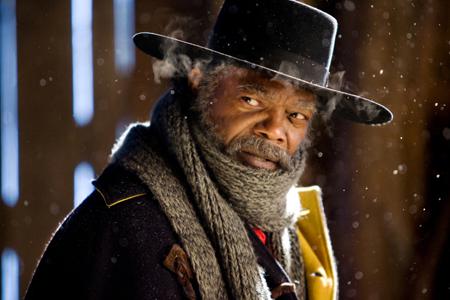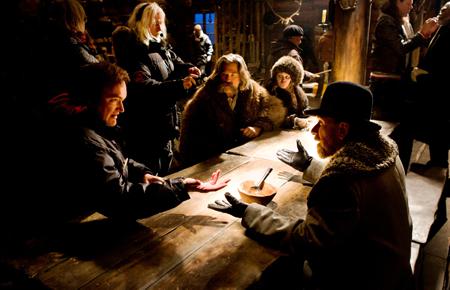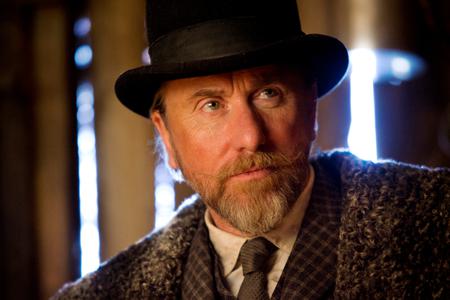Film (2015)
Written and directed by Quentin Tarantino
Somerville Theater
Davis Square, Somerville, MA
With Samuel L. Jackson (Major Marquis Warren), Kurt Russell (John Ruth), Jennifer Jason Leigh (Daisy Domergue), Walton Goggins (Sheriff Chris Mannix), Demián Bichir (Bob), Tim Roth (Oswaldo Mobray), Michael Madsen (Joe Gage), Bruce Dern (General Sandy Smithers), Channing Tatum (Jody)

in “The Hateful Eight”
Photo: Andrew Cooper, SMPSP / © 2015 The Weinstein Company
All Rights Reserved.
A bounty hunter, John Ruth (Kurt Russell), with prisoner Daisy Domergue (Jennifer Jason Leigh) in tow, are on their way via coach to the town of Red Rock so that he can get his reward and she can be hanged. They are encountered by Major Marquis Warren (Sanuel L. Jackson), another bounty hunter, who asks to venture along with them. Caught in a blizzard, they stop at a cabin along the way where they encounter an old army general, Sandy Smithers (Bruce Dern). Soon thereafter, a bunch of other guys including Oswaldo Mobray (Tim Roth), Joe Gage (Michael Madsen) and Sheriff Chris Mannix (Walton Goggins) show up and, after some long and tedious conversation, the fun begins.
This is classic Tarantino in every sense: full of blood and gore, and lots of long, sometimes exasperatingly boring, conversation.
The first part of this three and a quarter hour film is long and attenuated – much conversation that doesn’t seem to go anywhere – frankly, I was on the edge of sleep for most of it. Occasionally there is a characteristic Tarantino touch that livens things up a bit, usually involving John Ruth bashing Daisy Domergue in the face. She spends virtually the entire first part of the film smeared with blood, and it only gets severely worse in the second part.
After the intermission (yes, the film does, like in the good old days, have one!), things pick up considerably. All of a sudden, Major Warren becomes like an Inspector Poirot who tries to decipher what is not right in the situation. As he proceeds along his logical way, guns get fired and things start to happen. To make a long story short, if you liked the gory end of Tarantino’s Pulp Fiction (1994), you’ll love the second part of The Hateful Eight.

on the set of “The Hateful Eight”
Photo: Andrew Cooper, SMPSP / © 2015 The Weinstein Company
All Rights Reserved.
Tarantino does not hold back from showing any level of gore, and there’s plenty of it here. The interesting thing about his approach is that there’s so much irony mixed in with the drama that very little actual catharsis occurs. As with Pulp Fiction, Tarantino explores how much violence he can get away with while still making his audience smile. Personally, I find it difficult to smile under such circumstances, but there are plenty of people who watch Tarantino’s films and simply regard them as spoofy enough not to take seriously.
I do find Tarantino’s specialty – faux violence – to be a curiosity, but also a form of dramatic humor that seems to ride on a boundary which doesn’t quite satisfy either the humorous or the dramatic impulse. In Shakespearean tragedy, there is certainly tons of blood and also, sometimes intermixed, a good deal of humor. Witness the combination of all the murders in Hamlet with the funny chit chat of the gravediggers. But in Shakespeare the tragic part is not actually portrayed as humorous; that part is tragic and the humorous part complements it but is kept separate from it. In Tarantino’s work, it’s just the opposite – the tragic part is made to seem humorous, and that combination produces an odd sensation – that the blood is not real blood, the murders are not real murders and that, in fact, nothing that one witnesses onscreen is very real at all.
All of that may well be part of Tarantino’s meta-aesthetics of film and an attempt to somehow claim, through example, something about the tendency towards imaginative captivity one undergoes in a theater. If that is his intent here, it’s not an unreasonable thing to put forth through example, though the result feels a bit disingenuous. It’s like Republicans arguing that government is too powerful, then doing everything they can to run the government the way they want. I’m not sure that’s what Tarentino is up to, but it seems that he offers sufficient ridicule of standard dramatic forms to make one think that he never enters into them wholeheartedly.

in “The Hateful Eight”
Photo: Andrew Cooper, SMPSP / © 2015 The Weinstein Company
All Rights Reserved.
Whatever he does also does not feel like satire which typically removes itself enough with a wink of the eye to really enable the viewer to stand outside the action and look into it with ironic distance. Somehow Tarantino wants to bring his viewers in and to push them away at the same time. What he’s up to is not entirely clear, though some people find it very entertaining.
The second half of this film is a lot better than the first, though Tarantino might well argue that the first is a necessary build-up for what comes afterwards. If one watches Eugene O’Neill’s Long Day’s Journey Into Night (1956), at four hours plus even longer than The Hateful Eight, one has much the same feeling during the first few acts. Tarantino does not capture his audience with a sense of tragic entanglement in the way O’Neill does, but the timing is more or less the same. With Tarantino, unlike O’Neill, one comes out wondering whether the long slow build-up was worth it given what comes afterwards. At the end of Long Day’s Journey, one is more or less emotionally floored. At the end of The Hateful Eight, one is somewhat astonished, fairly disgusted and pushed to the point of a wry but wan smile wondering what it’s really all been for.
I saw the film in 70mm which is being promoted as a big deal. It’s a nice tribute to film itself which is going the way of all cinematic flesh these days, but there’s not enough real cinematography in this film to make much of a difference. I noticed it at the beginning when there were big landscape vistas, and once or twice during the inside shots which make up the rest of the film. Otherwise, it didn’t make much of a difference to me at all.
Ennio Morricone’s lively score provides a varied tonal landscape to the action, often humorous and offbeat. It provides a nice touch throughout, reassuring the viewer that none of this awful looking stuff is to be taken too seriously.
The introductory titles advertise The Hateful Eight as the eighth of Tarantino’s films. In this regard, it seems like a play on Federico Fellini’s 8 1/2, similarly named for its position in the director’s roster. The suggestive similarity of tone in Morricone’s music to that of the great Nino Rota’s music for 8 1/2 is another reminder, though in other respects the two films are as far apart as could be.
– BADMan
Leave a Reply